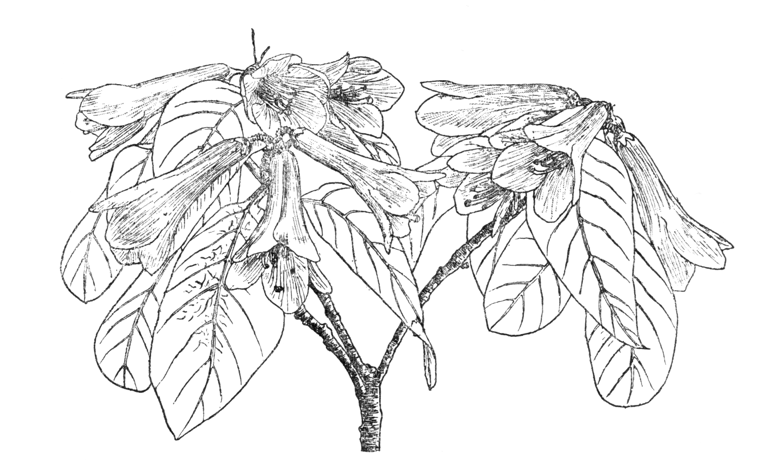An evergreen shrub 6 to 10 ft high, sometimes taller, somewhat thin and sparse of habit, the branches long and slender, scaly when young. Leaves 2 to 4 in. long, 3⁄4 to 11⁄4 in. broad; oval, tapering about equally to each end, glabrous, and of a greyish-green metallic lustre above, scaly beneath, and varying in colour from glaucous green to reddish brown; stalk 1⁄3 in. long. Flowers funnel-shaped, and like those of Lapageria, 11⁄4 to 2 in. long, very variable in colour; ordinarily of a dull cinnabar red, produced during May and June, from five to eight in terminal heads. In other forms the corolla is orange-red outside, yellowish within, sometimes greenish. Flower-stalk 1⁄3 in. long, scaly. Calyx with four short, broadish lobes, and one longer narrow one, or sometimes with all five nearly equal, scaly. Stamens ten, scarcely so long as the corolla, hairy at the base, (s. Cinnabarinum)
Native of the Himalaya from E. Nepal to the region of the Tsangpo bend and slightly beyond, but not reported from Burma or China; discovered by J. D. Hooker in Sikkim and introduced by him in 1850. This distinct and interesting species is remarkable for the variability of the colour of its flowers and of the undersurface of its leaves. But the differences between some of the intermediate forms are so unimportant that botanists regard them all of one species. The following variants, mostly only of horticultural interest, have been named:
var. aestivale Hutch. – This name was given by Dr Hutchinson to a plant growing at Borde Hill, Sussex, which was unusually late-flowering (July) and had narrower leaves than normal.
var. blandfordiiflorum Hook. – Flowers red outside, yellowish or greenish within. Bot. Mag., t. 4930. Introduced by J. D. Hooker. A plant of this character received an Award of Merit when shown from Bodnant on May 29, 1945.
var. pallidum Bot. Mag., t. 4788 – Flowers pale pinkish purple, rather widely funnel-campanulate, slightly speckled. Like the preceding, this was raised from the seeds collected by Hooker.
var. purpurellum Cowan – Flowers shorter than in the type and campanulate, rich plum-purple. Described from Ludlow and Sherriff 1354, collected in the Tibetan Himalaya in 1936. Award of Merit May 1, 1951, when shown by Capt. Collingwood Ingram, Benenden, Kent (raised from Ludlow, Sherriff, and Taylor 6349).
var. roylei (Hook, f.) Hort. R. roylei Hook. f. – Flowers intense rosy red or plum crimson. It was originally described by J. D. Hooker as a species. A few years later he sunk it in R. cinnabarinum but in gardens the name R. roylei continued to be used by gardeners, ‘who, quite reasonably, refuse to call the dusky beauty by the same name as the smaller-flowered orange or madder-coloured one’ (W. Watson, Gard. Chron., Vol. 64 (1918), p. 38). A selection from the var. roylei, named ‘Magnificum’, received an Award of Merit when shown by Messrs Reuthe on May 7, 1918. This was described as having flowers dark crimson on the outside, orange-red inside. The same award was given on May 19, 1953, to a clone named ‘Vin Rosé’, with flowers described as Currant Red outside, Blood Red inside, shown by the Crown Estate Commissioners, Windsor Great Park.
R. cinnabarinum is a perfectly hardy species in a sheltered position, and needs only light shade. ‘This is one of those rhododendrons which looks its best when viewed with the sun behind a bush in flower. The effect is then dazzling, for there is a certain quality and brilliance added to the shining flowers, which is not noticeable when seen only against a dark background’ (Millais).
R. cinnabarinum is a parent of many fine hybrids, the best known of which are the Lady Rosebery and Lady Chamberlain grexes. Details of these and others will be found in the section on hybrids.


